Modeling of cascaded high isolation bidirectional amplification in long-distance fiber-optic time and frequency synchronization system*
Kuan-Lin Mu(穆寬林) Xing Chen(陳星) Zheng-Kang Wang(王正康) Yao-Jun Qiao(喬耀軍) and Song Yu(喻松)
1The State Key Laboratory of Information Photonics and Optical Communications,School of Information and Communication Engineering,Beijing University of Posts and Telecommunications,Beijing 100876,China
2School of Electronic Engineering,Beijing University of Posts and Telecommunications,Beijing 100876,China
Keywords: time and frequency synchronization,erbium-doped fiber amplifier,instability,Allan deviation
1. Introduction
The problem of transferring precision time and frequency(T/F) signals to a remote location is important in many areas, involving commercial applications and scientific experiments (e.g., telecommunications, metrology, navigation, and geodesy). Comparing with the satellite link, the optical fiber has recently attracted much attentions to build link for T/F synchronization.[1-3]A number of projects have confirmed that T/F synchronization based on optical fiber link can achieve higher transmission accuracy.[4-7]
In order to realize long-distance T/F synchronization,the power loss caused by transmission should be compensated for significantly improving the signal-to-noise ratio(SNR)of the detected signal. Currently,several papers used the single path bi-directional amplifier(SPBA),which has a simple structure,to amplify bidirectional signals in the same erbium-doped fiber(EDF).[8,9]However, the cascaded bidirectional operation by SPBA typically restricts the maximum gain to around 20 dB to avoid spontaneous lasing due to Rayleigh back-scattering and back-reflections.[10-13]High isolation Bi-directional erbiumdoped fiber amplifier(Bi-EDFA),[14,15]which usually includes filters and unidirectional isolators,can also be used to compensate the power attenuation in the system. It uses two pieces of EDFs to amplify the forward and backward signals, respectively. Though the high isolation Bi-EDFAs destroy the symmetry of the two-way link to a certain extent,high gain can be obtained with no spontaneous lasing as the filters and unidirectional isolators are used. So,the high isolation Bi-EDFAs are helpful for the ultra-long distance fiber-optic T/F transmission.
In addition to studying the structures of the amplifiers to realize long-distance T/F synchronization in optical fiber link,it is also necessary to analyze the noises in the system to improve the stabilities of the transmitted time and frequency signals. Usually, the method of experimental measurement or modeling can be used to analyze the fiber-optical T/F system.The experimental measurement can provide accurate performance index of the system, but it usually takes a long time(e.g., several days). And the data obtained by experimental measurement usually only reflect the overall performance of the system which can not show the influence of each independent devices. Through modeling method, we can understand the influence of each independent devices on the instability of the transmitted time and frequency signals from the physical mechanism,compare the noises introduced by the devices and point out the direction for improving the instability of the system. In 2012, ′Sliwczy′nski and Ko?odziej[16]have proposed the method of estimating the intensity noises induced by fiber and SPBAs in two-way fiber-optic T/F transfer system,and Liet al.[17]used the same method to analyze the noise sources in 200 km optical fiber link. Except for the intensity noises,some other research work has focused on the impact of the transfer delay fluctuations upon the T/F transfer instability. It was found that the transfer delay fluctuations caused by the variation of refractive index,the variation of fiber link length,and the drift of laser output wavelength are major factors of reducing the instability of T/F synchronization.[18,19]The main factors that affect the instability,including the intensity noises and transfer delay fluctuation caused by various variations,are given in the above papers,but no systematic analysis in a longdistance fiber-optic synchronization system which signal attenuation is compensated by the high isolation Bi-EDFAs.
In this paper, we will do the research on the intensity noises and transfer delay fluctuations in fiber-optic T/F synchronization system which signal attenuation is compensated by the high isolation Bi-EDFAs. The structure of longdistance optical fiber chain and our high isolation Bi-EDFAs for T/F synchronization have been shown.The intensity noises which originate from the amplifiers, laser and detector are first analyzed in Section 2. Comparing with the system amplified by SPBAs, the single Rayleigh backscattering noise,double Rayleigh backscattering noise and the backscattered amplified spontaneous emission(ASE)noise can be removed for one-way isolators and wavelength division multiplexers(WDMs)that used in our high isolation Bi-EDFAs. Then the transfer delay fluctuations caused by the variation in ambient temperature and the jitter in laser output wavelength are also studied. The calculated results show that the instability for a 1200 km free-running T/F synchronization system decreases first,from 2.7233×10-12(τ~1 s)to 7.9205×10-14(τ~54 s),and then increases to 2.0851×10-11with the average interval time enlarged to approximately 30000-35000 s.In Section 3, we will discuss the impact of the amplifiers’asymmetry on the performance of the T/F synchronization system. The instability caused by asymmetry isσ(τ~30000-35000 s)=2.6064×10-16if the total asymmetric length of the bidirectional link length is 30 m. A free-running frequency synchronization system, including three high isolation Bi-EDFAs, is carried out to verify the analysis in Section 4. The measured results show that the instability for a 125.58 km free-running frequency synchronization system isσ(τ~1 s)=2.7521×10-13,σ(τ~400 s)=1.3674×10-13.
2. Modeling of the instability of T/F synchronization system based on the high isolation Bi-EDFAs
When the transmission distance exceeds several dozen of kilometers,it is necessary to regenerate the signal,usually by using the EDFAs. The diagram showing the long-distance chain for T/F transmission withNsegments of optical fibers and high isolation Bi-EDFAs is presented in Fig. 1. In the laser transmitters (Tx) at both A and B sides of the link, the T/F signals (e.g., 1 pps, 2.4 GHz) supplied by local atomic clocks are coded on the optical carrier which is generated by a standard fiber laser or semiconductor laser. Then the signal is sent from Tx to the receiver (Rx) through the optical fiber link to discriminate,and the power loss is compensated by the high isolation Bi-EDFAs. In case of the time transfer, the 1-pps signal is next extracted from this discriminated waveform,whereas in case of the frequency transfer, this directly forms the output from the link. Then,both local and remote signals might be compared in a usual way, by using, e.g., the phase comparator or the time interval counter.

Fig.1. System structure diagram: (a)Long-distance link of optical fiber spans based on cascaded high isolation Bi-EDFAs for T/F synchronization. (b)Structure diagram of high isolation Bi-EDFA.There is about-45 dB crosstalk between adjacent channels of WDM,as shown by the dotted line in the figure. (c)Structure diagram of Uni-EDFA.WDM:wavelength division multiplexer,EDF:erbium-doped fiber.
2.1. Instability caused by intensity noise of the T/F synchronization system
Causes of stability degradation are the cumulative intensity noise and transfer delay fluctuation in the synchronous networks. Here, we first discuss the intensity noise which originates from the link (including fibers and the high isolation Bi-EDFAs),laser and detector.
2.1.1. Instability caused by intensity noise of the fiber and cascaded high isolation Bi-EDFAs
Considering the schematic diagram presented in Fig. 1,we should study the interfering signals from Rayleigh backscattering(marked asR1,...,N)and ASE noise(marked as ASE+1,...,Nand ASE-1,...,N,here ASE+1,...,Nare the ASE noise of the Uni-EDFAs used inA →Btransmission and ASE-1,...,Nare the ASE noise of the Uni-EDFAs used inB →Atransmission)which will impinge the receiver together with the desired signal.
Taking the optical signal emitted byAside as an example and focusing only on the most intense components, we may write the power received at theBside of the link as

wherePB←Ais the desired signal transmitted fromAside toBside,and the other terms in Eq.(1)designate unwanted interfering signals:PTB,BSE, single Rayleigh backscattering of the light output from the laser atBside,PTA,BDE,double Rayleigh backscattering of the light output from the laser atAside,P±ASE, ASE noise of the EDFAs, andP±ASE-BSE,the backscattered ASE noise. Based on the model shown in Fig. 1, the powers of the items in Eq.(1)can be calculated by using the following formulas:

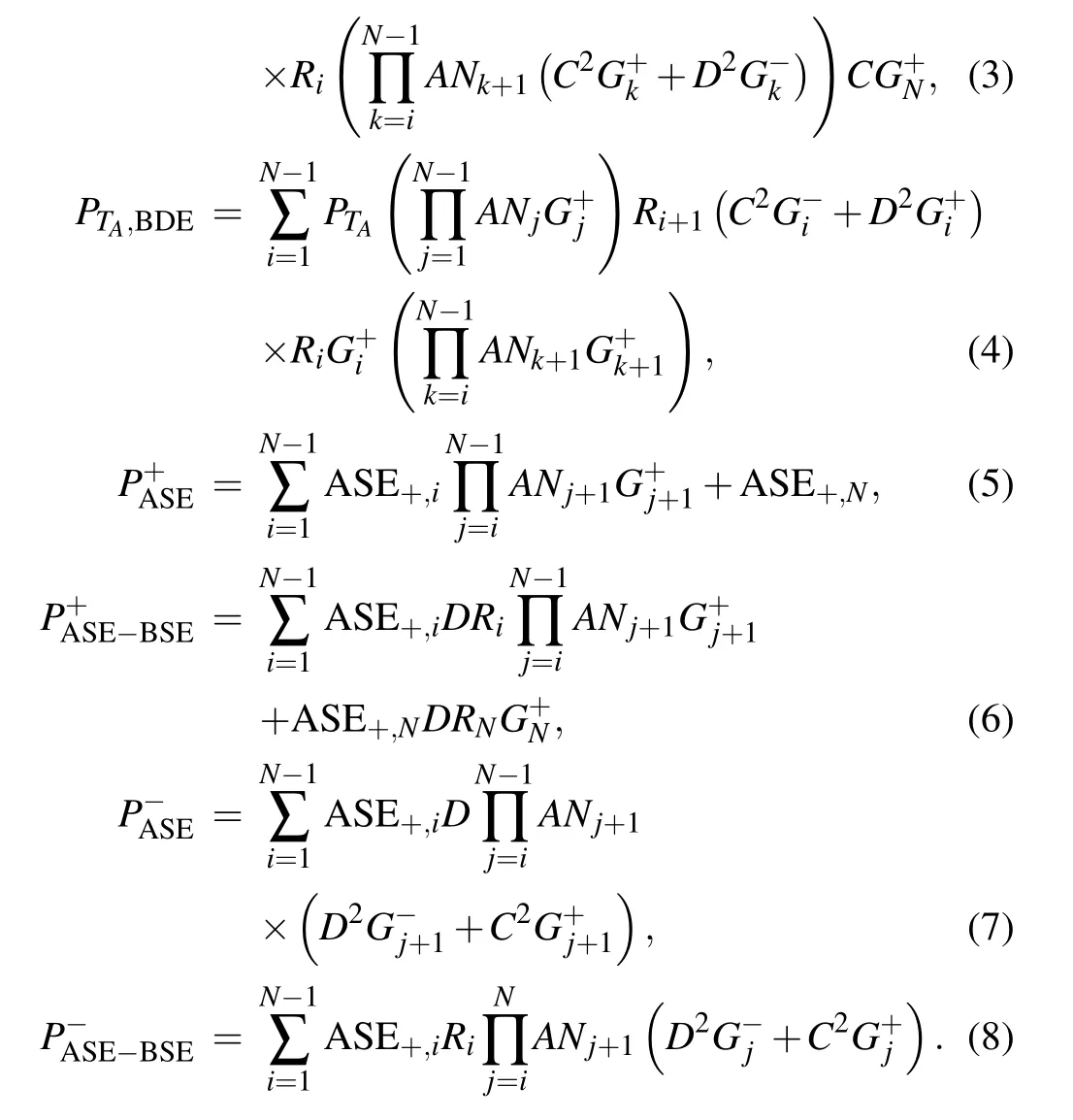
Here,ANis the attenuation of the fiber,Gis the gain of the amplifier,andCis the channel crosstalk coefficient of WDM.Our test results show thatC=-45 dB when the lasers wavelength fromAandBsides are in adjacent channels, and there is no crosstalk when non-adjacent channels are used.Dis the isolation degree of the isolator,and the isolation degree used in our amplifier is 42 dB.PTAis the optical power of the laser transmitter atAside. The loss of an individual fiber is estimated by the relationANi=exp(-αili), whereliis the fiber length andαiis the attenuation coefficient. The power of ASE can be calculated as ASE=2nsp(G-1)hvBopt,wherenspis the inversion parameter of erbium particles,his the Planck’s constant,vis the frequency of light andBoptis the optical bandwidth. In order to obtain the specific magnitude of the items in Eq.(1),we setPTA=PTB= 1 mW,α= 0.2 dB/km,nsp= 0.6, andBopt=100 GHz. The calculated results are shown in Table 1.

Table 1. Calculated power values of the optical signals.Adjacent channels of WDM are used:C=-45 dB
We can see that compared withPB←AandP+ASE, the values ofPTB,BSE,PTA,BDE,P+ASE-BSE,P-ASE,andP-ASE-BSEcan be ignored.This is why the spontaneous lasing can be suppressed even the high isolation Bi-EDFAs work in high gain state.
The optical signal which is given by Eq.(1)impinges the photodiode and generates electrical current, including some noise components apart from the useful signal. The current generated by the photodiode is proportional to the square of the amplitude of the electric field. Hence, we may write the equation for the electric signal in the B side receiver as

Equation (9) includes three terms where only the first one is responsible for transferring the T/F signal and other two terms should be regarded as noises, which will degrade the SNR of received signal. The second term results from the self-beating of the ASE noise,which with the variance is dependent on the electrical bandwidthBeland the optical bandwidthBopt. The last term is simply the signal-ASE beating noise. The expressions of the electrical noises are summarized in Table 2. ? is the responsivity of the photodiode.

Table 2. Electrical noises resulting from Eq.(9).
Having recognized the useful signal and the main noise sources,the SNR of received signal at the Rx side can be estimated as

whereκ2andκ3in the denominator denote the relative polarization between the electric fields beating in the detector.Then the Allan deviation denoting the instability can be obtained as[20,21]

Some illustrative examples are presented here to obtain an insight into the general performance of the discussed T/F synchronization system. For calculations,Bel=15 MHz,v0=2.4 GHz,m=1,?=1,andκ2=κ3=0.5.
More number of the high isolation Bi-EDFAs must be used to compensate the attenuation of longer link, and the distances between the amplifiers may vary. In order to simplify the analysis process,we simulate the SNR and instability degraded by the intensity noise of the fiber, the amplifiers in the assumption of the distances between the high isolation Bi-EDFAs are equal,and the gain of each amplifier just compensates the attenuation of the previous optical link. The curves in Fig. 2(a) show the trend of SNRI,1with the increase of link length in three cases of distance between amplifiers(i.e.,40 km,60 km,and 80 km). The curves in Fig.2(b)are the Allan deviation denoting the instability with an average interval time of 1 s. The curves in Fig.2(c)denote the Allan deviation as a function of average interval time,when the total length of the link is fixed to 1200 km, where the number of amplifiers are 30,20,and 15 for the fiber length of per segment as 40 km,60 km,and 80 km,respectively.

Fig.2. Performance of T/F synchronization system versus the intensity noise of the fiber and cascaded high isolation Bi-EDFAs: (a)SNR of the received signal versus the total link length; (b) Allan deviation of instability with an average interval time of 1 s versus the total link length;(c)Allan deviation as a function of average interval time for fixed 1200 km link length.
As can be seen from Fig. 2, with the increase of the link length, the number of amplifiers required will increase correspondingly, resulting in the accumulation of ASE noise.Therefore, the longer the link length is, the smaller the SNR of the received signal, which leads to a worse performance of the T/F synchronization system. For example, in the case of 400 km and 800 km link length where the distance of per segment is 80 km, the simulation results of SNRs are 60.457 dB and 57.443 dB,and the calculated Allan deviations are 1.0897×10-13and 1.5417×10-13(τ=1 s),respectively.Another feature is that the distance between the high isolation Bi-EDFAs in the link should not be too long-for the ASE noise is directly proportional to the gain of the amplifier. For the same link length of 1200 km, the SNRs of the received signals are 61.322 dB, 58.611 dB and 56.229 dB for amplifiers distance of 40 km,60 km and 80 km,and the corresponding Allan deviations are 9.6842×10-14, 1.3478×10-13and 1.773×10-13(τ=1 s), respectively. So when the power attenuation of the useful signal fromAside is just compensated,the SNR of the received signal(including the useful signal and the intensity noise)can be optimized by reducing the distances of the amplifiers. The trend of Allan deviation is linear and inversely proportional to the average interval time as can be seen from Fig.2(c).
2.1.2. Instability caused by other intensity noise of laser and detector
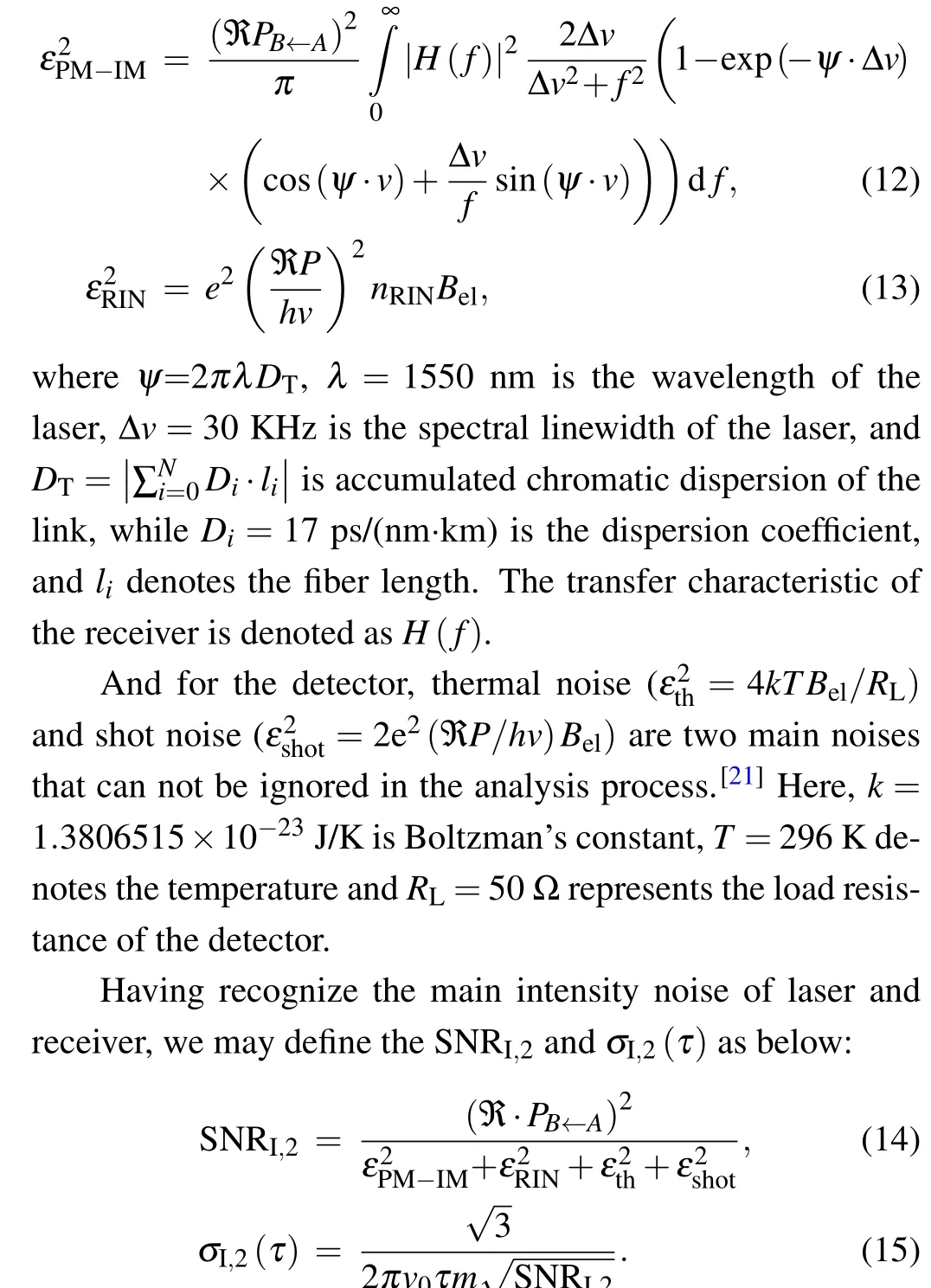
The conversion of the laser phase noise into the intensity modulation (PM-IM) noise occurs because of the chromatic dispersion of the fiber,and the relative intensity noise(RIN)of the laser should be considered.They can be expressed as[16,21]Figure 3 shows the calculated instability results caused by intensity noises of laser and detector. We can see the instability result is about 1.1189×10-14with average interval time of 1 s, which is smaller than that of 9.6842×10-14denoted by the red line in Fig. 2(c). The comparison results shows that the ASE noise introduced by the amplifier has more serious influence on the stability of the signals transmitted by the T/F synchronization system than that of the intensity noises introduced by laser and detector.

Fig. 3. Performance of T/F synchronization system versus the intensity noises of laser and detector. The link length is set as 30×40=1200 km,30 is the number of amplifiers and 40 km is the fiber length between amplifiers.
2.2. Instability caused by transfer delay fluctuation
Starting from the equation for the fiber propagation delayτ=Ln/c,whereLis the link length,nis the group refractive index andcis the velocity of light in vacuum.[18]As we know,the fiber length and refractive index will change with the temperature variation,resulting in the fluctuation of transfer delay time. Sinusoidal curve can be used to model the change of ambient temperature with time as ΔT(t)=Asin(2πt/T1),[20]whereAdenotes the amplitude, andT1(usually can be set as 1 day)is the period. Thus the Allan variance denoting the instability caused by temperature change in the length of optical fiber link can be calculated as follows:[21,22]

Similarly, the Allan variance denoting the instability induced by the temperature change in the refractive index can also be expressed as[21,22]

where?ΔL/?Tand?Δn/?Tare the variation coefficients of fiber length and refractive index following with temperature,respectively.
In Fig.4,the graphs of instability versus the transfer delay fluctuation caused by the link are drawn with the lines.The curves in Figs. 4(a) and 4(b) show instabilities which are affected by delay fluctuation introduced by the fiber length and fiber refractive index variation with temperature. Here, the link length is set to 400,800,and 1200 km,respectively. The temperature change amplitude is selected to be 10 or 0.1 degrees Celsius for the impact of the environmental temperature change on the fiber link will be reduced by 99%after the fiber is buried underground. The fiber group refractive index is set asn=1.45.
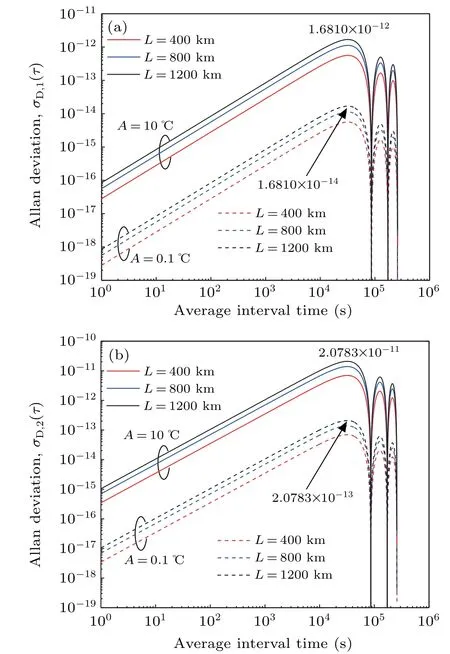
Fig. 4. Instability which is impacted by temperature fluctuation. (a) Instability which is impact by transfer delay fluctuation introduced by the fiber length variation following with temperature. (b)Instability which is impact by transfer delay fluctuation introduced by the fiber refractive index variation following with temperature.
As can be seen from Figs. 4(a) and 4(b), in the short term, the Allan deviationσD,1(τ) andσD,2(τ) are proportionally degraded to average interval timeτand link lengthL, and they reach the maximum whereτis enlarged to approximately 30000-35000 s. The value ofσD,1(τ)is less than that ofσD,2(τ) for?(ΔL)/?T=5.5×10-7°C-1is smaller than?(Δn)/?T=6.8×10-6°C-1. For a link length ofL=1200 km and temperature fluctuation range ofA=10°C,the peak value ofσD,1(τ) andσD,2(τ) are about 1.6810×10-12and 2.0783×10-11, respectively. If the temperature fluctuation range decreases toA= 0.1°C, the peak value ofσD,1(τ) andσD,2(τ) will upgrade to about 1.6810×10-14and 2.0783×10-13at the same average interval time of approximately 30000-35000 s, respectively. Whenτis larger than 3.5×104s,the Allan deviation decreases,and it becomes zero at one day, as well as its multiple numbers, because the temperature fluctuation is canceled under the assumption of sinusoidal curve.
The propagation time also depends on the wavelength of transmission signal via wavelength dependency of refractive index. So the laser frequency drift will also cause the jitter of the transmission signal delay in the T/F synchronization system. Chenet al.[21,23]have given out the Allan variance expression of instability caused by distributed feedback (DFB)laser wavelength drift in the fiber refractive index by integrating the frequency fluctuation noise PSD of a semiconductor laser,usingSv(v)=(K/v)+(Δv/π),[24]as follow:
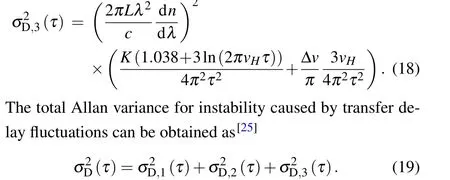
Calculated instability results caused by transfer delay fluctuations using Eq.(19)are shown in Fig 5. Here,the link length is set as 1200 km. The temperature fluctuation range is set asA=10°C.
As can be seen from the simulation results in the Fig.5,in the free-running situation, the output wavelength jitter of the laser mainly affects the short-term instability of the system,while the periodic change of temperature mainly degrades the long-term instability of the system.
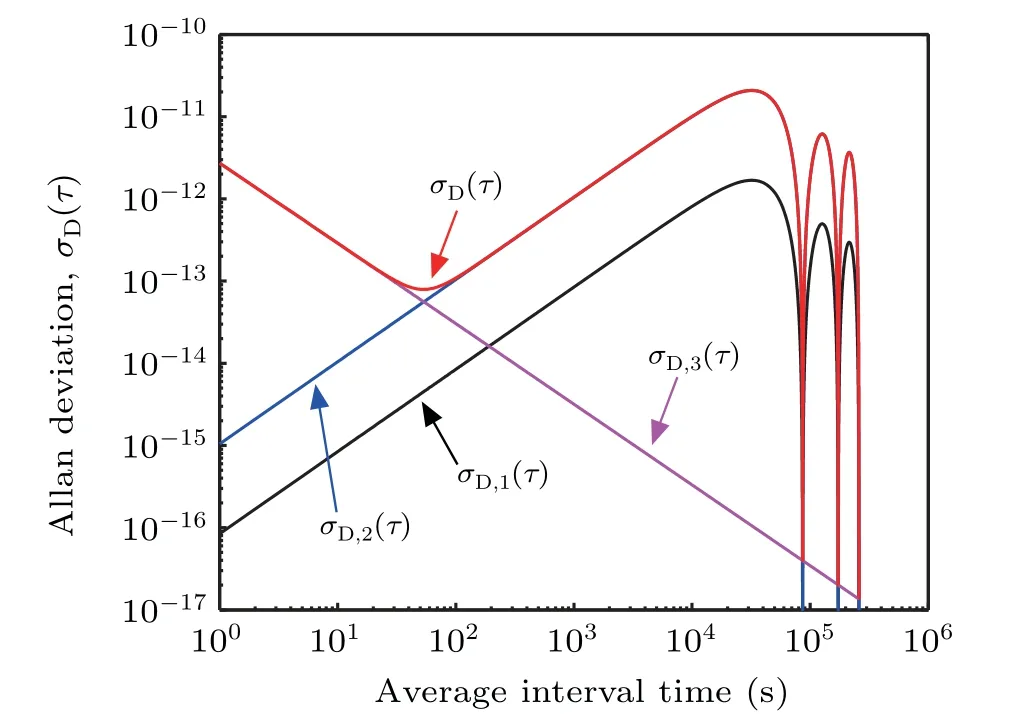
Fig.5. Calculated instability results caused by transfer delay fluctuations.
2.3. The total Allan deviation of the system
Finally,the performance of the free-running T/F synchronization system can be valued by summarizing the calculated results ofσI(τ) andσD(τ), corresponding to the factors of intensity noise and transfer delay fluctuations as below:

In Fig. 6(a), the black line is the instability result caused by intensity noise which originates from the laser,fiber,amplifier and detector. The blue line is the instability caused by transfer delay fluctuations. Though the red curve almost coincides with the blue curve, the red curve denotes the total Allan deviation of the free-running system. The total Allan deviation denotes the instability decreases first, from 2.7233×10-12(τ= 1 s) to 7.9205×10-14(τ~54 s), and then increases to 2.0851×10-11with the average interval time enlarged to approximately 30000-35000 s. And with the decrease of temperature fluctuation,the inflection point will move to the direction with longer average interval time, and the corresponding stability performance will be improved as shown in Fig. 6(b)(i.e.,7.9205×10-14(τ~54 s)forA=10°C,2.5361×10-14(τ~170 s)forA=1°C and 8.1150×10-15(τ~545 s)forA=0.1°C).

Fig.6. Total influence of various noises on T/F synchronization performance along 30×40=1200 km fiber link,30 is the number of amplifiers and 40 km is the fiber length between amplifiers: (a)Allan deviation denotes the instability of the free-running T/F synchronization system(the temperature fluctuation range is set as A=10 °C); (b) the total instability as a function of different amplitude of temperature fluctuation.
As can be seen from the simulation results,the short-term instability of the T/F synchronization system is limited by the accumulated ASE noises of the amplifiers and the frequency stability of the laser. The long-term instability is limited by the temperature fluctuation.
3. Asymmetry caused by the cascaded Bi-EDFAs
In the bidirectional T/F synchronization system,the bidirectional symmetry of the link is desired when we try to compensate the transmission delay fluctuation.[26]The high isolation Bi-EDFA in Fig. 1 uses EDFs, WDMs, pumps and isolators to form two Uni-EDFAs to realize the power compensation. This scheme can avoid spontaneous lasing and provide enough high gain for forward and backward signals in T/F system. However, it is difficult to ensure the consistency of the fiber length of the two Uni-EDFAs in the process of splicing. When multiple amplifiers are used as the relay system,the bidirectional symmetry of the whole link is destroyed.The uncertainty of transfer delay calibration caused by the link asymmetry can be calculated as

where ΔL′denotes total asymmetric length of bidirectional link,σ+D(L,τ) andσ-D(L-ΔL′,τ) denote the instability caused by propagation delay fluctuation in forward and backward directions,respectively.
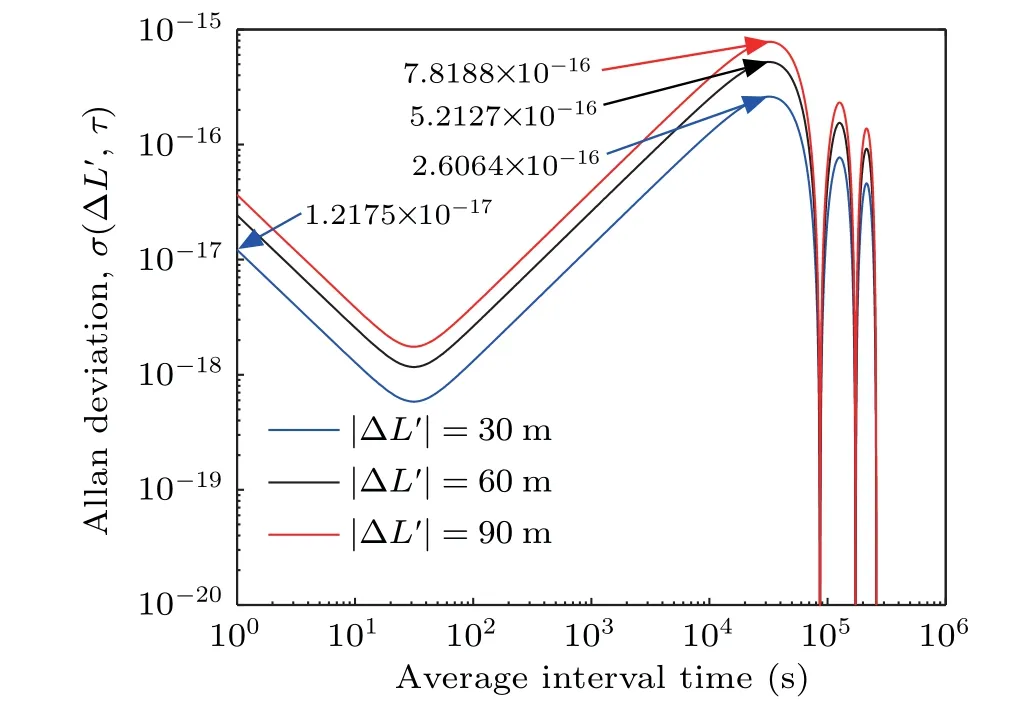
Fig.7. Instability which is impacted by the asymmetry of the link caused by high isolation Bi-EDFAs.
In Fig. 7, the graphs of instability which is impacted by asymmetry caused by Bi-EDFAs are simulated based on Eq. (21). Here the total link length is set asL=1200 km,the amplitude of the temperature fluctuationAis set as 10°C,and the fiber group refractive index is set asn=1.45. Just as shown in Fig. 7, when the total asymmetric length is set as|ΔL′| = 30 m, the calculated Allan deviations caused by asymmetry are 1.2175×10-17(τ~1 s) and 2.6064×10-16(τ~30000-35000 s). In addition, the longer asymmetry length will induce more serious impact on the instability of the system. The calculated instabilities are 2.6064×10-16,5.2127×10-16and 7.8188×10-16(τ~30000-35000 s)when the total asymmetry length are 30,60 and 90 m,respectively.
Comparing the results shown in Figs.2(c)and 7,it can be seen that the asymmetry of the Bi-EDFAs has a negligible impact on the short-term performance of the T/F synchronization system.But for large average interval time,around a day or so,the impact of asymmetry of the total link length is comparable with the result that be caused by the SNR of the intensity noise.
4. Experiments
A free-running frequency synchronization system is carried out to verify the analysis and methods presented in the preceding sections. The general measurement setup used during the tests is shown in Fig.8. A 2.4 GHz RF signal is generated by Agilent E8267D and divided into two signals by electrical coupler for transmission and reference respectively. A laser diode (LD) is modulated with the transmission RF signal through a Mach-Zehnder modulator(MZM).Firstly,three sections of fiber with length of 41.86 km are used and three Bi-EDFAs, shown as Fig. 8(b), are used to compensate the attenuation. Then, three variable optical attenuators (VOAs),shown as Fig. 8(c), are used instead of optical fiber to simulate different link attenuation. In addition, the transmission delay fluctuation caused by the influence of various aspects on the optical fiber are eliminated when VOAs are used. After a manual phase shifter MPS-DC4.2G-180-S,the demodulated 2.4 GHz RF signal received by the PD is mixed with the reference 2.4 GHz signal to detect the phase error. The phase error is transmitted to the voltage value by Keysight 34465A to calculate the Allan deviation.
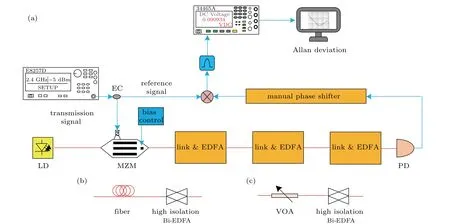
Fig.8. Experiment diagram of the free-running frequency synchronization system. LD:laser diode,MZM:Mach-Zehnder modulator,VOA:variable optical attenuator,PD:photodiode,EC:electrical coupler.
The experimental Allan deviations denoting the frequency instabilities of the free-running system are shown in Fig.9. Here,the measured results areσ(τ=1 s)=1.4548×10-14,σ(τ=1 s)=2.3841×10-14andσ(τ=1 s)=3.2079×10-14when the attenuation values of the VOAs are set as 8 dB,15 dB and 20 dB,respectively. When three sections 41.86 km optical fibers are used, the instability of the transferred frequency degrades toσ(τ=1 s)=2.7521×10-13. As the experiment is completed in an air-conditioned room, where the amplitude of temperature fluctuations is approximately a few degrees, and the period would be shorter than one day. The red line increases again when the average interval time is just larger than about 20 s and reaches 1.3674×10-13at approximately 400 s.
The experimental data is consistent with the simulation result.The higher gain provided by EDFA,the more noise will be brought to the system, which will deteriorate the stability of the transmitted frequency signal as shown by the pink,blue and black lines.Comparing the pink and red lines in Fig.9,the instability will just be affected by the intensity noise originating from the amplifier,laser and detector when VOAs are used,and the transfer delay fluctuation caused byσD(τ)should be considered in the real system which is composed of optical fiber.

Fig. 9. Instability of the free-running frequency transfer system. The numbers in the parentheses represent the power attenuation bring by fiber link and attenuators.
5. Conclusion
In this paper, we have analyzed the intensity noises and transfer delay fluctuations in the long-distance fiber-optic T/F synchronization system which is based on high isolation Bi-EDFAs. The high isolation Bi-EDFAs use two EDFs, incorporating with direction-separating components in the signal path(e.g.,optical isolators and WDMs),to amplify the signals in forward and backward directions, respectively. Compared with the SPBAs,such amplifiers can improve the SNR of the received signal at the remote side by blocking the propagation of backscattered signals which will interfere with transferred T/F signals. And the high isolation Bi-EDFAs can be used to realize the ultra-long distance fiber-optic T/F transmission.
The models presented in this paper takes into account of the intensity noises to estimate the SNR at the receiver of the T/F system,including the ASE noise of the high isolation Bi-EDFAs, the RIN of the laser and the conversion of the laser phase noise into the intensity noise that occurs because of the fiber chromatic dispersion,the thermal noise and shot noise of the detector.We have also considered the transfer delay fluctuations caused by the variation in fiber link length,the variation in refractive index and the jitter in laser output wavelength.The results of the performed research show that the short-term instability of the T/F synchronization system is mainly limited by the ASEs noise and the laser frequency drift, while the long-term instability is limited by the periodic variation of ambient temperature impact on the fiber.
A free-running frequency synchronization experiment has been done with three variable optical attenuators(VOAs),incorporating three high isolation Bi-EDFAs, to prove our theoretical predictions. The measured instability wasσ(τ~1 s)=1.4548×10-14when the attenuation values of the three VOAs are set as 8 dB. When three sections of 41.86 km optical fibers are used to instead of the VOAs,the instability of the transferred frequency degraded toσ(τ~1 s)=2.7521×10-13andσ(τ~400 s)=1.3674×10-13for the optical fibers will introduce the transfer delay fluctuations.
The asymmetry caused by the high isolation Bi-EDFAs will deteriorate the long-term instability of the T/F system for the bidirectional transmission delay fluctuations are unequal and can’t be fully compensated.
- Chinese Physics B的其它文章
- Projective representation of D6 group in twisted bilayer graphene*
- Bilayer twisting as a mean to isolate connected flat bands in a kagome lattice through Wigner crystallization*
- Magnon bands in twisted bilayer honeycomb quantum magnets*
- Faraday rotations,ellipticity,and circular dichroism in magneto-optical spectrum of moir′e superlattices*
- Nonlocal advantage of quantum coherence and entanglement of two spins under intrinsic decoherence*
- Universal quantum control based on parametric modulation in superconducting circuits*

